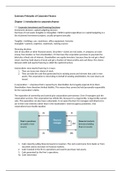Summary Principles of Corporate Finance
Chapter 1: Introduction to corporate finance
1.1 Corporate Investment and Financing Decisions
Investment decision: capital budgeting decision
Purchase of real assets (tangible or intangible). CAPEX (capital expenditure) or capital budgeting is a
list of planned investment projects, usually prepared annually.
Tangible = buildings, cars, machinery, office equipment, factories
Intangible = patents, expertise, trademark, training courses
Financing decision:
Sale of securities or other financial assets. Securities = claims on real assets. A company can raise
money from lenders or from shareholders. If it borrows the corporation promises to pay back the
debt plus a fixed rate of interest. Shareholders are equity investors, because they do not get a fixed
return, but they hold shares of stock and get a fraction of future profits and cash flows. The choice
between debt and equity financing is called the capital structure.
Corporations raise equity financing in 2 ways:
1. They can issue new shares of stock.
2. They can take the cash flow generated by its existing assets and reinvest that cash in new
assets. The corporation is reinvesting on behalf of existing stockholders. No new shares are
issued.
A corporation = a business that is owned by its shareholders but is legally separate from them.
Shareholders have therefore limited liability. This means they cannot be held personally responsible
for the corporation’s debts.
The separation of ownership and control give corporations permanence. Even if managers quit the
corporation survives. The corporation has infinite life, because it is a legal entity. A legal entity cannot
vote. This separation can also have a downside. It can open the door for managers and directors to
act in their own interests rather than in the stockholders’ interest (agency problems). And
corporations have double taxation.
1. Cash raised by selling financial assets to investors. The cash could come from banks or from
securities sold to investors in financial markets.
2. Cash invested in the firm’s operations and used to purchase real assets.
3. Cash generated by the firm’s operations.
4a. Cash reinvested.
, 4b. Cash returned to investors.
1) Primary Market e.g. IPO (initial public offering) where securities are sold
directly to the investors and the funds go to the issuing firm.
e.g. SEO (seasoned offering) is a 2nd share issue where the funds
from the sale of the securities flow from the investor to the
issuing firm.
2) Secondary Market Investors trade (buy and sell) securities with each other. Funds
of the sale go to the seller of the securities NOT to the firm!
(via stock exchanges e.g. AEX, CAC40, FTSE, Dow Jones etc.)
1.2 The Financial Goal of the Corporation
There is a natural financial objective on which almost all shareholders agree: Maximize the current
market value of shareholders’ investment in the firm. Shareholders can all do more when their
shares are worth more. Financial managers need to increase market value.
As long as a corporation’s proposed investments offer higher rates of return than its shareholders
can earn for themselves in the stock market, its shareholders will applaud the investments and its
stock price will increase. But if the company earns an inferior return, shareholders boo, stock price
falls and stockholders demand their money back so that they can invest on their own.
Opportunity cost of capital = expected return that is foregone by investing in a project rather than in
comparable financial securities. Whenever a corporation invests cash in a new project, its
shareholders lose the opportunity to invest the cash on their own. Corporations increase value by
accepting all investment projects that earn more than the opportunity cost of capital. If the company
is making a risky investment, the opportunity costs is the expected return that investors can achieve
in financial markets at the same level of risk.
Agency costs = costs that arise when an agent (manager) does not act solely in the interests of the
principal (the shareholder).
Accounting = more dedicated to reporting with a book value approach / records the past / works
with real amounts
Finance = more dedicated to decision making with a market value approach / estimated future cash
flows / works with forecasts
,Chapter 2: How to calculate present values?
Present Value = the amount of money we have now (at t=0).
Future Value = the amount of money that will be available in the future (at t=t).
All Cash Flows will take place at the end of a period.
2.1 Future Value
FVt = Future Value
CF0 = Principal
r = Interest rate
t = always in years
Simple interest
- You will receive interest on the amount deposited in your bank account
- You will NOT receive interest over interest
Formula to find the future value of simple interest:
FVt = CF0 x (1+rt)
Compound interest
- You will receive interest on the amount deposited in e.g. your bank account;
- You will receive interest over the received interest and amount deposited.
Formula to find the future value of compound interest:
FVt = CF0 x (1+r)^t
2.2 Present Value
Formula to find the present value (PV):
PV = FVt / (1+r)^t
Discount factor (DF):
DF = 1 / (1+r)^t
Net Present Value (NPV)
The Net Present value is calculated to establish whether an investment project should be accepted or
not, taking into account the ‘time value of money’ of the projected Cash Flows!
In case the NPV is larger than 0, an investment project should be accepted.
In case the NPV is less than 0, an investment project should be rejected.
The formula for calculating the NPV:
NPV0 = -C0 + Cft / (1+r)^t
NPV = -Investment + PV Cashflows – PV refits + PV scrap value
YOU ALWAYS CHOOSE THE HIGHEST NPV IF THERE ARE 2 PROJECTS
Higher cashflows in the beginning, lead to a higher NPV.
C0 = the Cash Flow at time 0. It is usually a negative number. C0 is an investment and therefore a
cash outflow.
, Suppose you believe the project is as risky as investment in the stock market and that stocks are
expected to provide a 12% return, than 12% is the opportunity cost of capital for your project. That is
what you are giving up by investing in the office building and not investing in equally risky securities.
Return on investment = profit / investment
Justify the investment by either one of the following two rules:
1. Net present value rule: Accept investments that have positive net present values
2. Rate of return rule: Accept investments that offer rates of return higher than their opportunity
costs of capital.
The interest rate on the loan has nothing to do with the risk of the project.
2.3 Perpetuities
A cash flow can be constant and indefinite in time = Perpetuity where t=∞ .
For a Perpetuity, the cashflows continue indefinitely. An example of a Perpetuity are e.g. the
so-called Consols. They are debt in the form of a Bond. The government however, for this
particular Bond, never has to repay the Principal of the Bond and only has as an obligation to pay the
fixed interest (=coupon) to the owner of the Consol (in perpetuity).
Cash Flow C
Rate of return on a perpetuity = ------------------ = r = ----
Present Value PV
The price (= PV) of a Consol therefore can be expressed as followed:
Cf
Present Value = ----
r
This value is just one period before the first payment. If the first payment is for example in six years,
the result of the formula is at time 5. You have to add the discount formula. (1+Im)^-t
The formula to obtain the present value for a geometric perpetuity:
C1 = cash flow 1
r = interest rate
g = growth rate
V0 = C1 / (r-g)
It is obvious that an increase in interest rate / discount rate r has a negative effect on the price of the
consol. (Inflation is not good for the owner of the Consol!) On the other hand it can be concluded
that if the price of the Consol in the market increases, this must be the result of a drop in the interest
rate on the market! Remember this inverted relationship between price and discount rate / interest
rate.
Perpetuity due: You have to add the correction function = (1+Im) !!






